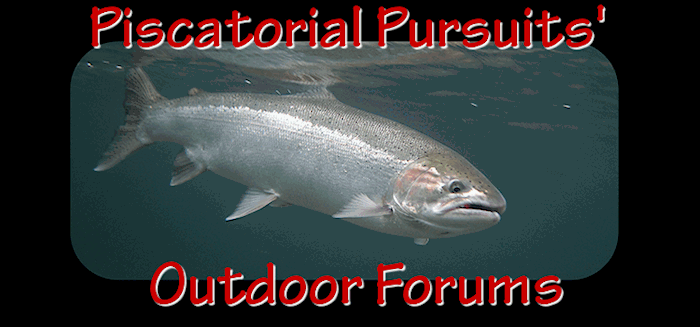#99185 - 11/10/00 12:09 PM
 Blackmouth: curtains of death?
Blackmouth: curtains of death?
|

Parr
Registered: 09/05/00
Posts: 41
Loc: Eagledale, WA
|
I enjoy fishing for blackmouth in the winter but the fish are year-round residents in the local waters. Question: Is the DFW blackmouth program hurting the native and hatchery runs? Blackmouth salmon in Puget Sound and the Strait of Juan de Fuca number in the millions and are very carnivorous. They seem willing to attack anything that moves that may be edible. Are these planter fish eating the precious output from our rivers and hatcheries as they attempt to make their way to the open sea as juveniles? Have you long timers on this board discussed this or does anybody know if any studies have been done in this regard? Could this be as serious an impact on the runs as dams, nets and habitat or am I jumping to delusions?
|
|
Top
|
|
|
|
#99186 - 11/10/00 03:07 PM
 Re: Blackmouth: curtains of death?
Re: Blackmouth: curtains of death?
|

Returning Adult
Registered: 07/28/99
Posts: 447
Loc: Seattle, WA, USA
|
Good question, and I doubt its been looked at. My gut feeling is that sufficient ecological partitioning occurs between blackmouth and outmigrating smolts. It is surprising how much the outmigrating smolts are beach huggers, particularly chinook, chum, and pinks. Many migrate in the intertidal zone at high tide. As the smolts move away from shore, they tend to spread out, making themselves less of an aggregative target.
I've caught the occasional blackmouth from the beach, but generally they like deeper waters, so would not likely come into substantial contact with the juveniles. Adult sea-run cutthroat and char are a different story. These guys are shallow water dwellers and are documented smolt feeders. Adult coho are also beach huggers, but their migration back into the sound does not correspond to juvenile outmigration from streams. I do, however, recall opening up a beach caught coho on Whidbey and finding a smolt.
I don't know how many blackmouth are released into the sound each year, but its logical to think that they shouldn't be released to the same degree as the ocean dwellers. Any long-timers out there have any thoughts as to how blackmouth fishing is now compared to 20-30 years ago?
|
|
Top
|
|
|
|
#99187 - 11/10/00 03:59 PM
 Re: Blackmouth: curtains of death?
Re: Blackmouth: curtains of death?
|

Parr
Registered: 05/31/00
Posts: 42
Loc: Federal Way
|
I am not an "old timer" but I will share what I have learned about the blackmouth. Resisent Chinook (blackmouth) have allways existed in the inland waters. In the past(20-30 years ago) they were primarily make up of wild fish that had a natural deviation from their normal migration habits. As time has gone on and wild fish numbers have declined, the WDFW looked for a way to suplement the population of blackmouth to maintain the fishery. They found that by holding the juvinile Chinook in the hatchery holding ponds for an extra year, it broke the instincts of those fish to go out to sea.
This does not mean that if left alone the fish would not migrate back to their rivers of origin.
As far as their impact on hatcher fish, they ARE hatchery fish. If they eat each other, fine.
The WDFW has somehow determined that the impact on the small wild population is insignificant but the reduction in the length of the winter fishery is a result of concern that wild blackmouth are being caught. I expect that when the fin clipping of hatchery Chinook becomes more wide spread that we will see selective regulations in effect and possibly a full winter season
|
|
Top
|
|
|
|
#99188 - 11/10/00 04:29 PM
 Re: Blackmouth: curtains of death?
Re: Blackmouth: curtains of death?
|

Returning Adult
Registered: 06/29/00
Posts: 437
Loc: Kitsap County
|
I inspect the stomach of all the blackmouth I keep and have never found a smolt in one. However, during July several of the early silvers we caught at Jeff Head were full of smolts. I have no idea what type.
In regards to fishing of yesteryear, an older gentleman I fish with occaisionally says that in the 1970's blackmouth were much more prevalent in the central sound, that many days he would start trolling inside of Winslow harbor and limit without ever getting past the ferry dock.
[This message has been edited by Chip Goodhue (edited 11-10-2000).]
|
|
Top
|
|
|
|
#99189 - 11/10/00 06:07 PM
 Re: Blackmouth: curtains of death?
Re: Blackmouth: curtains of death?
|

Returning Adult
Registered: 07/28/99
Posts: 447
Loc: Seattle, WA, USA
|
Boy those are early silvers. But it makes sense, most smolts (all species) outmigrate from streams during the spring and summer, just in time to be mowed down by those guys. Smolts are usually pretty scarce by September/October when the bulk of the adult silvers come in.
|
|
Top
|
|
|
|
#99190 - 11/10/00 07:28 PM
 Re: Blackmouth: curtains of death?
Re: Blackmouth: curtains of death?
|

Parr
Registered: 09/05/00
Posts: 41
Loc: Eagledale, WA
|
I agree that when targeting the resident fish in the winter we typically fish deep and this year (particularly for me anyway) the bigger blackmouth have been very deep. This summer, however, I was hooking them throughout the water column while fishing silvers and I've kind of come to the conclusion that these guys are likely to show up anywhere that they can find something to eat. One can imagine that in the old days the ratio of naturally occurring resident fish (blackmouth) to the huge biomass of anadromous juveniles was probably such that predation (if it occurred at all considering all of the more preferable food sources around) probably didn't have much effect on the ocean bound smolt. Do we potentially have a situation today, though, where we are artificially boosting the numbers of hungry stay-at-homes thus creating a bloody gauntlet that the smaller numbers of normal juveniles who are trying to get out of town in May and June can't get through without substantial losses? Probably have to do a gut check on a bunch of blackmouth in the late spring to find the answer but the season isn't open then.
|
|
Top
|
|
|
|
#99191 - 11/12/00 11:44 PM
 Re: Blackmouth: curtains of death?
Re: Blackmouth: curtains of death?
|

Returning Adult
Registered: 09/21/00
Posts: 408
Loc: marysville,wa
|
I always check the stomach contents of the fish I catch and fifty prcent of the time they are empty. The ones that do have undigested food in them usually have been feeding on candlefish. I dont think that your concerns about blackmouth are valid. It's been my experiance that the smaller smolts cruise in the top fify feet and the larger blackmouth are on the bottom most of the time (feeding on candle fish which are much more numerous and slower) thus mother nature has separated them on in her own way
|
|
Top
|
|
|
|
|
|
Arimadude19, Blue Duck, Cygnus, Fishstik, gary mercer, johnny46, McDeek, Mike Boettcher, RDHarper, Sparky, TacomaKid |
|
|
0 registered (),
482
Guests and
2
Spiders online. |
|
Key:
Admin,
Global Mod,
Mod
|
|
11504 Members
17 Forums
72984 Topics
825727 Posts
Max Online: 3937 @ 07/19/24 03:28 AM
|
|
|













 Previous Topic
Previous Topic Index
Index

